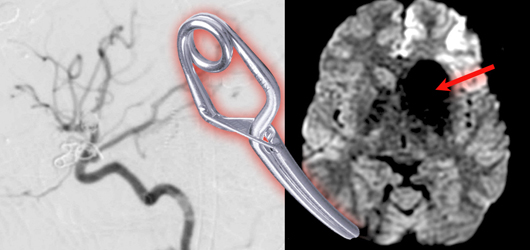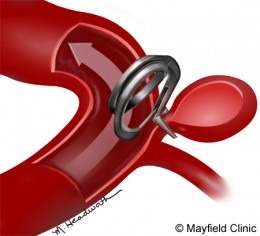
Every year neurosurgeons treat nearly 17,000 brain aneurysms in the United States by placing a metal clip across the aneurysm’s neck. The metal clips, which are made of titanium or a metal that contains nickel, are usually safe. But for the patient who is allergic to nickel, which is often found in inexpensive jewelry, the procedure can lead to rare but serious complications.
A case study is presented by Ryan Tackla, MD, a resident in the University of Cincinnati Department of Neurosurgery, and Andrew Ringer, MD, a vascular neurosurgeon at the Mayfield Clinic, in the July issue of Surgical Neurology International.

The case involved a 33-year-old woman who was admitted to the emergency department at the University of Cincinnati Medical Center after developing a life-threatening allergic vasculitis following the clipping of her brain aneurysm several weeks earlier. The case was baffling. Why would this patient continue to deteriorate, suffering seizures and the death of brain tissue after what seemed like a successful clipping of her aneurysm?
Her healthcare team at the Comprehensive Stroke Center at the UC Neuroscience Institute had to figure out why her condition continued to plummet. On imaging studies, they watched a cascade of decline affect her brain’s delicate blood vessels and nerves. The physicians ran test after test, hoping to find a clue that would lead them to a diagnosis. The patient had said previously that she did not have a metal allergy, and her family affirmed this. Finally, there was no other option: she would have to undergo another brain surgery so that her surgeons could examine her brain.
A biopsy of fluids near the injured tissues was taken during surgery, and the findings raised the possibility of an allergic vasculitis. “Fluids indicating inflammation were accumulating in the blood vessels,” Dr. Tackla explained.
The neurosurgeons proceeded to consult with specialists in rheumatology, allergy, and immunology, who confirmed her allergy to nickel. Dr. Ringer operated a second time, replacing the nickel alloy clip with one made of titanium, a more biocompatible metal. With the new clip in place, the patient was later discharged to a rehabilitation facility, facing a difficult recovery.
Nickel allergies affect 10 percent of Americans of all ages and are more common in women than men. Sensitivity develops after repeated exposure, such as wearing inexpensive jewelry, having body piercings, or working with a particular metal, such as nickel. Once sensitized, the immune system will always react, often in a rash or blistery irritation.
How big is the risk for patients who receive metal aneurysm clips or other metal devices, such as stents, orthopedic implants, or dental implants? When Drs. Tackla and Ringer reviewed the literature, they found reports of metal allergies to be quite rare.
Dr. Tackla urges everyone to make sure your medical history is up to date with a family member. “Even what seems like a small detail, such as an allergic reaction to jewelry, could become vitally important,” he says.
Dr. Ringer urges surgeons to consider this potentially severe complication, to screen appropriately, and to use titanium metal to greatly reduce metal allergy risks. He explains, “At the Mayfield Clinic, we no longer use use nickel-containing clips, thus reducing the likelihood of an allergic complication.”
The study’s other co-authors were Andrew Grande, MD, a neurosurgeon at the University of Minnesota, and Sanjeet Grewal, MD, a neurosurgical resident at the Mayo Clinic in Jacksonville, Fla.
— Mary Kemper